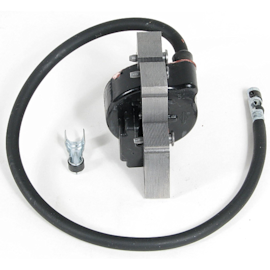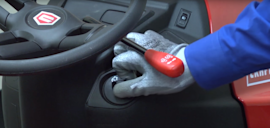6 weeks to a better lawn


If your lawn's spring rebirth is less than glorious thanks to weeds, dead spots and lackluster color, spring is the time to shape it up.
During your lawn's spring growth spurt, it responds quickly to your improvement efforts. But don't wait: After the growth spurt starts, you have about six weeks until grass growth slows way down, when summer turns hot and dry. That's true whether you live in the northern US and have a cool-season grass like Kentucky blue or fescue, or live in the Deep South and grow a warm-season grass like Bermuda or St. Augustine.
Mow more often
Grass grows fast in spring; even faster if you fertilize it. Don't try to get away with a once-a-week scalping. Cutting off more than about 1/3 of the lawn's height forces the grass to deplete the food stored in its roots to replace its lopped top. And depleted roots lead to a weaker lawn that's ill-equipped to cope with heat and dryness. If you're truly committed to a better lawn, be prepared to mow twice a week in spring.
You'll get a cleaner cut if you use a sharp blade. If you notice that the tips of the grass are tattered instead of sliced, it's time for a new blade. Check out our selection of top-selling mower blades.
Of course, it's hard to mow if your mower is on the fritz. If that's the case, check out our DIY lawn tractor repair and lawn mower repair info. If your mower is just needing a tune-up or routine maintenance, we have the products and tools for that too.
Feed your grass
Applying half the yearly fertilizer amount now gives your lawn a quick boost at a critical time (apply the other half in early autumn). Use an organic lawn fertilizer—organics are so widely sold now that there's no excuse to use a synthetic one.
To take feeding to the next level, apply a micronutrient treatment. Liquid seaweed contains a host of trace minerals (warning: it's stinky). Or for a deep green lawn that will make your neighbors green with envy, try an iron supplement.
Control the weeds organically
The safest option is to dig or pull up weeds. Even if you don't get the whole root, you've weakened the weed and kept it from producing seeds.
If pulling isn't enough firepower for your weed problem, spot treat existing weeds with a weed killer spray, which is safer than dousing the whole lawn. Look for an organic week killer that contains concentrated iron—the ingredients will list either iron HEDTA or FeHEDTA. The iron controls or suppresses broadleaved weeds such as dandelion, white clover and plantain, but doesn’t kill the grass. Brand names as of this writing include Ortho Elementals Lawn Weed Killer, Whitney Farms Lawn Weed Killer, Natria Lawn Weed Control and Fiesta Turf Weed Killer.
To control broadleaf weeds before the seeds sprout—and to feed your lawn—apply corn gluten meal. Garden centers carry corn gluten meal labeled for weed control, in both dry and liquid forms. Corn gluten meal keeps the seeds of crabgrass, dandelions and some other weeds from growing. The trick is to apply it before seeds start to sprout. In spring, that’s usually around the time the crocus and forsythia start blooming.
Repair dead spots in the lawn
All sorts of mishaps can kill spots in the lawn—spilled fertilizer, dog urine, insect damage. Patch small areas with sod cut from an inconspicuous part of the yard.
Reseed larger areas and keep the soil surface moist until the grass fills in—deep watering isn’t needed, you just need to keep the grass seeds from drying out. Depending on the temperature and wind, you might have to spray water on the area twice a day at first.
Remedy trampled areas
Grass grows poorly in compacted soils, giving less finicky weeds the chance to move in. Hot spots are the well-used shortcuts across the lawn or the strip next to the driveway that you drive on when backing out. You have two options:
Fight it. Loosen compacted soil to about 6 inches and reseed. Then train people to take the sidewalk and learn how to use your car's side mirrors.
Don't fight it. Make a path of bark chips or stepping stones where everyone walks. Replace the grass strip adjacent the driveway with a wide band of bricks or pavers, or cover it with bark mulch.
Be realistic
You do not live in a fertilizer ad. You do not have a grounds crew to pamper your lawn. No one has found a way to add hours to the day. Until you remedy any of these situations, you're never going to have a lawn that is utterly and eternally perfect. But with this six-week program, you’ll have a greener, healthier lawn.
Most common symptoms to help you fix your riding mowers & tractors
Choose a symptom to see related riding mower and lawn tractor repairs.
Main causes: worn or broken blade belt, broken belt idler pulley, blade clutch cable failure, bad PTO switch, damaged ma…
Main causes: faulty battery, bad alternator…
Main causes: punctured tire or inner tube, leaky valve stem, damaged wheel rim…
Main causes: dead battery, stale fuel, bad starter solenoid, ignition system problem, bad ignition interlock switch, clo…
Main causes: damaged tie rods, bent or worn wheel spindle, worn front axle, damaged sector gear assembly…
Main causes: shift lever needs adjustment, neutral control needs adjustment…
Main causes: clogged carburetor, damaged flywheel key, dirty spark plug, stale fuel, improper valve lash, engine needs a…
Main causes: worn or broken ground drive belt, bad seat switch, transaxle freewheel control engaged, transaxle failure, …
Main causes: unlevel mower deck, dull or damaged cutting blades, worn mandrel pulleys, bent mower deck, engine needs tun…
Most common repair guides to help fix your riding mowers & tractors
These step-by-step repair guides will help you safely fix what’s broken on your riding mower or lawn tractor.

How to replace a mandrel assembly on a riding lawn mower
Replace the mandrel assembly if the blade shaft vibrates or doesn't spin.…

How to replace the flywheel key on a riding lawn mower
If the engine won't restart after hitting a stump or rock, the problem could be a sheared flywheel key. Follow these ste…

How to replace a riding lawn mower ignition coil
If you're not getting spark from a good spark plug, the problem could be the ignition coil. Follow these step-by-step in…
Effective articles & videos to help repair your riding mowers & tractors
Use the advice and tips in these articles and videos to get the most out of your riding mower or lawn tractor.

Learn about all the convenient features on our Sears PartsDirect website that make your parts purchases easier.…

Get answers to frequently asked questions about Sears and Sears PartsDirect.…

Check the starter solenoid, starter motor, wiring, battery and engine.…